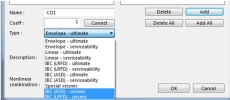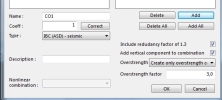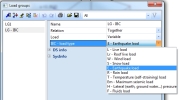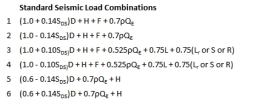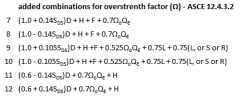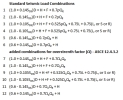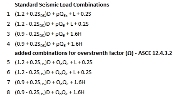Seismic combinations
Description
Automatic seismic combinations are available in projects calculated according to the IBC code.
Non orthogonal seismic components - e.g. 100% EQX + 30% EQY - may be taken into account using appropriate settings in the seismic action load group.
Make sure, that all relevant seismic load cases are assigned to the same load group.
To take into account non orthogonal seismic components, use a seismic load group with the relationship "Together"
To ignore non orthogonal seismic components, use a seismic load group with the relationship "Exclusive"
Procedure to input seismic combination in project
- There is a need to have several seismic Load cases in the project. (type - variable and specification - Seismicity)
- These seismic Load cases must be in the same Load Group with relation - together.
- And there must be the IBC code set in the project.
- Then the new type of combination appears - "IBC (ASD) - seismic" and "IBC (LRFD) - seismic"
- For these two combination type new settings will appear"
- checkbox "Include redundancy factor of 1.3"
Only for horizontal seismic loading. It will be used in seismic combinations according IBC
- checkbox "Add vertical component to combination"
User can take or do not take vertical component of seismicity into account.
- combobox "Overstrength" with three possibilities: "Exclude overstrength combos", "Create only overstrength combos" and "Include overstrength with all combos"
Only for horizontal seismic loading. It will be used in seismic combinations according IBC, see ASCE/SEI 7-10 - table 12.2-1 Design Coefficients and Factors for Seismic Force-Resisting Systems
- "Overstrength factor" with defaul value 3.0
Background
After adding all load cases to these combination, SCIA Engineer automatically generates combinations according IBC code depended on user settings in combination dialogue.
Dependencies for all combinations
- Load cases are marked according "IBC - load type" in Load groups dialog. In combination schema Qe = E.
- If checkbox "Include redundancy factor of 1.3" is ON, the coefficient "p" in combination schema is set as 1.3. If checkbox is OFF the coefficient "p" in combination schema is set as 1.0.
- If checkbox "Add vertical component to combination" is ON, the coefficient "SDS" in combination schema is taken from IBC seismic spectrum. If checkbox is OFF the coefficient "SDS" in combination schema is set as 0.
- The value of "Overstrength factor" enters into the combinations as coefficient "Ω".
Combinations
- IBC (ASD) - sesmic combination
- IBC (LRFD) - sesmic combination
- Overstrength is set as "Exclude overstrength combos"
- Overstrength is set as "Create only overstrength combos"
- Overstrength is set as "Include overstrength with all combos"
- Overstrength is set as "Exclude overstrength combos"
- Overstrength is set as "Create only overstrength combos"
- Overstrength is set as "Include overstrength with all combos"
Special seismic combination
For both allowable stress design and strength design methods where specifically required by the code, elements and components shall be designed to resist the forces calculated using Equation 16-22 when the effects of the seismic ground motion are additive to gravity forces and those calculated using Equation 16-23 when the effects of the seismic ground motion counteract gravity forces.

where:
Em = The maximum effect of horizontal and vertical forces as set forth in Section 12.4.3 of ASCE 7.
f1 = 1 for floors in places of public assembly, for live loads in excess of 100 pounds per square foot (4.79 kN/m 2 ), and for parking garage live load, and
= 0.5 Regular live loads.
An additional info on live load reduction valid for all IBC combinations may be found in Live Load Reduction chapter.

